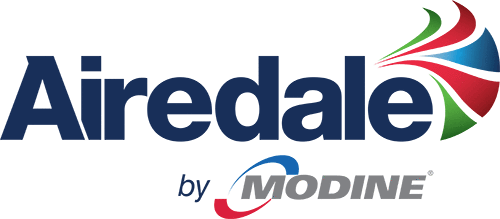Sustainable Cooling Solutions for High-Density Data Centers
The extraordinary growth of cloud services and AI applications, along with the resultant increase in data processing needs and network traffic, is driving unprecedented demand for data center capacity. According to the global consulting firm McKinsey & Co, total data center capacity could nearly triple by 2030. As data centers strive to meet the growing demand, many operators, particularly hyperscalers, are pushing toward ever-higher rack densities.
But increasing rack loads is not without its challenges. As heat loads rise, traditional cooling strategies are insufficient to meet operational and environmental needs.
To keep up with data processing demand without compromising sustainability goals, next-generation facilities must prioritize highly efficient, scalable cooling solutions. Airedale by Modine is at the forefront of this new technology.
Understanding the New Cooling Imperative
Air cooling remains essential across much of the data center—especially for lower-density storage and networking gear—and many server components can still be cooled by air. But as rack densities climb, the highest-power CPUs and GPUs are driving the search for better options.
What’s Driving the Shift?
Increased workload demands from AI and machine learning, cloud services, and edge computing, as well as the robust digital infrastructure that modern businesses require, have significantly increased the need for data center capacity. Large language models and other machine learning applications rely on massive training datasets and computational resources.
Meanwhile, the development of edge computing moves data processing closer to data sources. The edge computing model relies on a distributed architecture that requires smaller, more efficient, localized data processing.
Both of these models, hyperscale data centers serving multiple purposes and devices, and hyper-local data centers that are processing data at its source, need more efficient cooling systems. Modern GPUs and tensor processing units (TPUs) drastically outperform older CPUs, but they also generate much more heat as a byproduct of the increased processing power.
AI-focused data centers have also increased their rack density, with 80kW or more per rack becoming standard. At the same time, customers, investors, and regulators are pressuring operators to reduce power usage effectiveness (PUE). Low PUEs can give you a competitive advantage, and using a more efficient cooling option is one of the most effective ways to achieve it.
Environmental Impact of Cooling
Cooling can account for 30% to 40% of a data center’s energy usage. Evaporative cooling methods can consume a tremendous amount of water, particularly in hot climates. Older systems often use refrigerants that are bad for the environment. They have high lifecycle emissions that increase the carbon footprint. Leaks and other mechanical inefficiencies make the problem worse.
The Rise of Liquid Cooling
As data center operators look to lower their emissions profile and find more energy-efficient cooling options, many are turning to solutions such as liquid cooling. In addition, innovative developers are also working to create data centers with net-zero emissions by incorporating elements in line with initiatives such as renewable energy and heat recovery.
Why Liquid Cooling?
Liquid is much more effective at removing heat than air, easily handling the increased rack densities of AI-focused data centers—even during maximum use—without thermal throttling. And it can even reduce data center emissions by 21%, according to a study by Microsoft.
Liquid cooling moves heat directly away from the chip or chassis, so you can create more compact server arrangements. You don’t need hot and cold aisle separation and extensive ductwork, or to build a server room with varying floor heights and extensive perimeter space. You can build data centers that have more computing power per square foot and have tighter thermal tolerances for more uptime.
Airedale’s Liquid Cooling Portfolio
Airedale offers flexible liquid cooling solutions that are designed for high-performance, AI-optimized workloads. Coolant Distribution Units (CDUs) are the foundation of the system. They have 400kW to 200+MW liquid-liquid heat exchange capability that works in both liquid-cooled and hybrid data centers. With front access to control panels, VSDs, expansion tanks, and filters, you can change or add to your configuration as needed. They support modular and scalable deployment, so you can use them for both hyperscale and distributed architectures. The modular, precise design works well for retrofitting existing data centers as well as new construction.
The Middle Market Catching Up: Colocations and the Path to Liquid Adoption
Hyperscale and self-contained data centers aren’t the only use cases for liquid cooling. Many colocation providers in the middle market are exploring options for adapting to client demands for high-performance computing and GPU-dense workloads. These operators often need to work with legacy infrastructure, so they can’t start from scratch the way greenfield data center operators can.
Air Cooling Isn’t Dead, but It’s Evolving
Colocation providers still have to rely on traditional computer room air conditioning (CRAC) and computer room air handling (CRAH) units, particularly for dealing with mixed workloads. These units have historically supported lower-density racks, but they’re not up to handling larger rack densities alone. To support this market, Airedale offers advanced air-cooled chillers and in-row cooling units. Air-cooled chillers can reduce your overall energy usage by lowering your need for refrigerant. In-row cooling units can target hot spots in denser racks and reduce your power usage while allowing you to keep using a legacy floor plan.
Bridging Technologies: CDUs in the Colo Space
As smaller operators experiment with liquid cooling, CDUs offer a nondisruptive, incremental way to implement liquid cooling into existing operations. Operators can incorporate them as they onboard clients who are running HPC or GPU-intensive applications. CDUs bridge the gap by managing the interface between the facility’s water supply and targeted liquid cooling options for specific clients. Taking a phased adoption approach allows operators to take on new clients who can benefit from liquid-cooled technology without needing to completely redesign their infrastructure.
Airedale’s Approach to Hybrid Cooling
Although liquid cooling may be the best option, we realize that it’s not feasible for most data centers to completely retrofit buildings and servers to work with liquid cooling. At Airedale by Modine, we support realistic options for gradually transitioning to more energy-efficient cooling. We have systems that adapt to both air- and liquid-based needs. You can blend technologies based on your workload and your floor-plan restrictions. Our open system design is compatible with a wide range of IT gear and third-party infrastructure, so you can meet your clients’ needs. Flexible control systems and software integrations empower you to dynamically optimize your thermal performance.
Sustainability by Design: Making Cooling Smarter and Greener
We’re committed to designing smarter, greener cooling systems that give you measurable results through increased efficiency and lower PUE. Our systems do this through:
Hardware Efficiency
Airedale’s hardware uses low-GWP refrigerants that have less environmental impact than traditional hydrofluorocarbons (HFCs). Our chiller designs have heat-recovery systems integrated so you can capture waste heat, then reuse it for other needs like hot-water heating or space heating. The modular systems let you scale as you need to in order to reduce idle waste.
Intelligent Controls and Software
Using historical data and AI, Airedale’s software provides full-stack thermal management. It includes predictive analytics so you can stay ahead of demand spikes and conserve energy during slow times and offers you the ability to manage your energy use remotely. These models help minimize your overall power and water usage.
Quantifiable Results
Airedale’s combination of efficient hardware and intelligent software delivers measurable results for your data center. You can lower your PUE even in high-density environments by reducing your energy consumption. An optimized system consumes less power and water, directly lowering both your operating expenses and your carbon emissions.
One of our recent colocation clients implemented Airedale’s hybrid cooling technology with integrated AI controls. Over the course of a year, they reduced their PUE from 1.38 to 1.21 by reducing their cooling-related energy consumption by 19%.
Designing for the Future: Scalability and Circularity
Your cooling system needs to be able to adapt to support growth and meet customer demands without requiring a complete overhaul. With Airedale, you can do this through:
Scalability Without Compromise
Airedale’s modular system is designed to grow with your data center. You can add, swap, or reconfigure your system as needed without extensive retrofitting or downtime. Your cooling system will work with new zones and higher rack densities, while supporting the transition to liquid cooling.
Circular Cooling Principles
Data center designers and operators evaluate cooling on total cost of ownership—maintenance, power and water, and uptime risk—not just first cost. Airedale engineers systems for the full lifecycle, with serviceable layouts that simplify upkeep, scalable configurations that adapt as densities rise or hybridize with liquid, and materials and processes chosen to support refurbishment and recycling at end of life. The result is lower lifetime cost per kW cooled and practical circularity.
Partnering with the Right Stakeholders
Sustainability doesn’t hinge on only one element. You need to collaborate with all relevant stakeholders to create comprehensive, eco-friendly systems. This includes architects, data center operators, and environmental, social, and governance (ESG) leaders, so you can work together to meet your targets.
Cooling with a Conscience
Cooling isn’t about the right product, it’s about engineering a solution. And it’s an important factor in your sustainability mandate. Hyperscalers can partner with Airedale to optimize liquid cooling at scale. Colocation providers can explore hybrid options that balance legacy infrastructure with modern demand. Everyone can join Airedale in rethinking data center cooling from the ground up with innovative, environmentally friendly solutions. Reach out today to learn how we can help.





